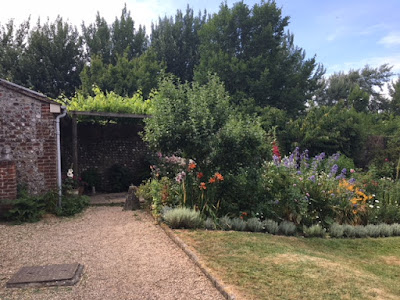 |
| Lewes is a small, lovely town on the River Ouse, located a few miles away from the farmhouse. |
This group included one of my favorite authors, Virginia Woolf, her husband Leonard, her sister Vanessa Bell (an artist), Vanessa's husband Clive Bell (an art critic), artist Duncan Grant (Vanessa's lover), writer E. M. Forster, writer Lytton Strachey (who also was cousin and lover to Grant), and a few others. Woolf pioneered a new style of modernist writing in her fiction and her essays, and post-impressionist painters like Vanessa Bell and Duncan Grant challenged traditional art techniques in favor of bold, fresh techniques. Some members of the Bloomsbury group were related by blood, others by marriage, and many of them had both marriages and affairs within the circle itself. It's quite a messy and compelling history -- I first learned about the "Bloomsberries" for a research project, and I've been interested in them ever since.
This is what took me to the Charleston Farmhouse, the home of Vanessa Bell and Duncan Grant and later Clive Bell; it was a sort of necessary pilgrimage for me, a recently converted scholar of modernism (I use the term "scholar" quite loosely here). Only a few miles away from Virginia Woolf's late residence, the Charleston Farmhouse served as a meeting point for intellectuals and artists with a new mode of art. Woolf was a frequent visitor at her sister's farmhouse, and I learned on my tour of the house that one of my favorite poets T. S. Eliot had visited and had even recited his masterpiece The Waste Land in the parlor of the home.
Part of the fun of this journey was getting to the farmhouse. Located near Lewes, a small town about 1.5 hours' train ride from central London, the farmhouse is only served by one bus service on some days at very particular times. I was happy to be accompanied by Holly, another huge fan of the Bloomsberries and of Virginia Woolf, although she's a little more art-savvy than me.
**Edit: Here lie the remnants of an embarrassing story about my dear friend Holly. I have removed it for her comfort and dignity.
So once we arrived safely, it was well worth it. The Charleston is situated amongst acres of farmland and is surrounded by beautifully maintained gardens. The house itself is filled with color and original decorations (including wallpaper, tables, light fixtures, paintings, and plates) painted by Vanessa Bell and Duncan Grant. Grant's old art books still line the shelves, and the painting studio looks practically untouched since the artists last used it. Unfortunately, no photos were permitted in the house, but I got plenty of pictures of the outside.
While the Bloomsbury group was named for where they first formed -- in the London neighborhood of Bloomsbury -- the Charleston Farmhouse largely serves as a symbol of the group and the intellectual and artistic progress for which the group is responsible. I made sure to stop for a piece of cake (have I mentioned how wonderful the cakes are in the UK?), in this case a divine orange cake. It was surreal and humbling to be standing in the same places as some of the most formative thinkers of the twentieth century, and it was a visit I won't soon forget.




No comments:
Post a Comment